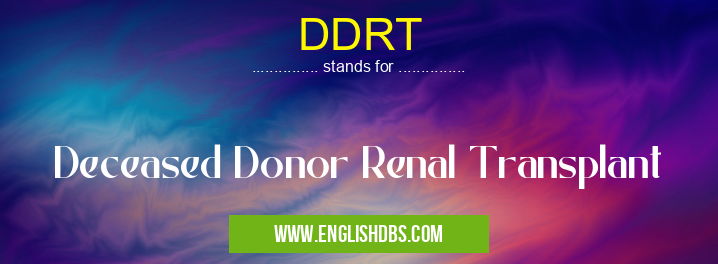What does DDRT mean in TRANSPLANTATION
Deceased Donor Renal Transplant (DDRT) is a procedure in which a donor's kidney is transplanted into the recipient. The kidney comes from a recently deceased donor and is surgically implanted into the body of the recipient. DDRT can help people suffering from end-stage renal failure improve their quality of life, as well as potentially reduce their risk of death. In this article, we will discuss what exactly DDRT entails as well as answer some FAQs about this procedure.

DDRT meaning in Transplantation in Medical
DDRT mostly used in an acronym Transplantation in Category Medical that means Deceased Donor Renal Transplant
Shorthand: DDRT,
Full Form: Deceased Donor Renal Transplant
For more information of "Deceased Donor Renal Transplant", see the section below.
Essential Questions and Answers on Deceased Donor Renal Transplant in "MEDICAL»TRANSPLANTATION"
What are the benefits of DDRT?
DDRT offers numerous benefits to those with end-stage renal failure, including an improved quality of life, reduced risk of death, and potentially lower rates of dialysis use. Additionally, recipients may experience improved functioning of the donor organ over time following transplantation.
Are there any risks associated with DDRT?
As with any medical procedure, there are potential risks associated with DDRT such as infection, rejection of the donor organ, and side effects from medications needed for immunosuppression. It is important to talk to a medical professional about these risks before undergoing DDRT.
Who is eligible for DDRT?
Generally speaking, those who are 18 years or older and have end-stage renal failure may be eligible for DDRT. However, it is important to keep in mind that not everyone will qualify due to certain medical conditions or other factors such as blood type incompatibility between donor and recipient. Additionally, availability of organs can vary depending on geographical location.
How long does it take to recover after DDRT?
Recovery time varies depending on each individual's case; however, typically patients undergo a period of hospitalization followed by several weeks or months at home recovering before resuming normal activities. Additionally continuing regular health monitoring visits with your healthcare provider is recommended following any transplant surgery.
Is it possible to receive more than one kidney transplant?
Yes, it is possible for some individuals to receive more than one transplant from different donors if needed; however every case should be evaluated individually before considering any additional transplants.
Final Words:
Deceased Donor Renal Transplant (DDRT) offers an effective solution for many people who suffer from end-stage renal failure by providing improved quality of life as well as potentially reducing morbidity and mortality rates in certain cases where appropriate. It's important to talk to your healthcare provider if you think you may be eligible for this procedure so that you can make an informed decision based on all available facts concerning risks and expected outcomes regarding your own unique situation.
